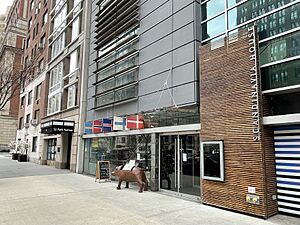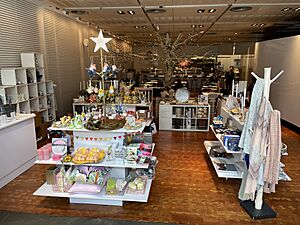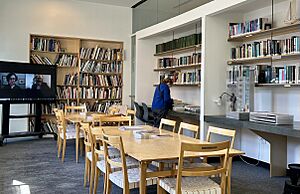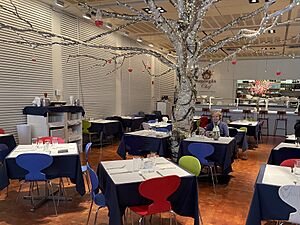Scandinavia House – The Nordic Center in America facts for kids
 |
|

Scandinavia House
|
|
| Established | 2000 |
|---|---|
| Location | 58 Park Avenue Manhattan, New York 10016 United States |
| Architect | James Stewart Polshek of Ennead Architects |
| Public transit access | Subway: Bus: M1, M2, M3, M34, M34A, M42, M101, M102, M103 |
Scandinavia House – The Nordic Center in America is a special place in New York City that celebrates the culture of Scandinavian and Nordic countries. It's located on Park Avenue in Manhattan. This center helps people in the United States learn about the history, art, and traditions of countries like Denmark, Finland, Iceland, Norway, and Sweden. You can see cool art and design, watch performances, and even learn Nordic languages here.
A famous architect named James Stewart Polshek designed Scandinavia House. It first opened in 2000. Important guests like the King and Queen of Sweden, and princesses from Norway and Denmark, attended the opening.
Scandinavia House opened in 2000. It was built by the American-Scandinavian Foundation (ASF). This foundation wanted a permanent home to share Nordic culture in the United States. Before this, ASF had moved around for ten years. Building the new center cost about $13 million.
Since it opened, more than 1.5 million people have visited Scandinavia House. The president of ASF, Edward P. Gallagher, said it was a "fully public building." This means it's open for everyone to enjoy. It offers many programs that show the lively culture of Denmark, Finland, Iceland, Norway, and Sweden.
Scandinavia House has different kinds of events. These include art shows, film series, concerts, and other performances. They also have readings, talks, language classes, and fun activities for children.
The Building's Design
The Scandinavia House building has a modern design. It was created by Polshek Partnership Architects. The building has six floors above ground and two floors below. It is about 50 feet wide.
The design uses simple, clean lines, which is typical of Scandinavian style. The outside of the building is made with gray and light blue zinc and glass. The goal was to show off Scandinavian building materials and new technology. It also aimed to create open spaces that can be easily changed for different events.
Scandinavia House has several special areas. These include the 168-seat Victor Borge Hall for shows and talks. There's also a 3rd Floor Gallery for art exhibitions. The Heimbold Family Children's Learning Center offers programs for kids and families. You can also find the Halldór Laxness Library here.
Lower Level: Victor Borge Hall
The Victor Borge Hall is a performance space. It has modern technology and can seat 168 people. This hall hosts many events. These include talks, presentations, concerts, and film screenings throughout the year.
Main Floor: Cafe and Shop
The main floor has the F. Donald Kenney Reception Area and Taplin Café. This large space overlooks Park Avenue. It is home to the Björk Cafe & Bistro. The area is open and transparent, so you can see the street from inside. People on the street can also see into the building. This is a common feature in modern architecture.
Near the entrance, there is a small gift shop. It sells Scandinavian design items, souvenirs, and sweets. There is also a section that sells clothing, jewelry, books, and textiles.
Second Floor: Volvo Hall
The Volvo Hall is a bright and impressive space. It has glass walls on both sides that look out onto Park Avenue. Next to it is a garden terrace. This outdoor area has stone and wood details. It's a great spot for outdoor parties or meeting breaks.
Volvo Hall can hold up to 250 guests for receptions. It can seat 120 people for dining. This hall is used for fashion shows, presentations, and official gatherings. It also hosts social events and educational programs by ASF. There is also an outdoor Wallenius terrace on this floor. It's used for serving guests during the summer.
Third Floor: Art Galleries
The Stolt-Nielsen, Gundersen, Ginsberg, and Leif Hoegh Galleries are on the third floor. These galleries show amazing Scandinavian art. You can see paintings, sculptures, photography, and design. Past exhibitions have featured famous Nordic artists like Edvard Munch. There have also been group shows with major artworks from each Nordic country. These exhibitions often come with related events. These include talks, discussions, films, and art workshops.
Fourth Floor: Library and Kids' Center
The Halldór Laxness Library is on the fourth floor. It is decorated in classic Scandinavian design. Large windows offer a great view of Park Avenue and New York landmarks. Computers with internet access are available. There is also a small reading area next to the main part of the room.
The Heimbold Family Children's Playing and Learning Center is also on this floor. It is open to members during the week. On Saturdays, it is open to everyone.
Fifth and Sixth Floors: Offices
The offices for the American-Scandinavian Foundation and Scandinavia House are on the fifth and sixth floors. These floors also have conference rooms. These include the Statoil and Teekay Conference Rooms. There is also the Barbro Osher Pro Suecia Foundation Seminar Room.
Restaurant: Björk Cafe & Bistro
On the first floor of Scandinavia House, you'll find the Björk Cafe & Bistro. Chef Ulrika Bengtsson and Sabina Lindmark run this restaurant. They serve Nordic fusion dishes. The previous restaurant was called Smorgas Chef. It closed around 2022.
Scandinavia House receives support from many donors. There are up to 300 donors from the U.S. and other countries. These include individuals, companies, and foundations. The Nordic governments and the Nordic Council of Ministers also contribute.
The American-Scandinavian Foundation (ASF) manages Scandinavia House. Niels Poulson founded ASF. He was a Danish-American who owned a successful iron manufacturing company. In 1910, he started ASF (first called the American Scandinavian Society). It is a non-profit organization that gets public funding.
ASF's goal is to support cultural activities. It does this by offering many fellowships, grants, and internships. It also publishes materials. ASF was one of the first non-government groups to promote cultural ties between countries.
A board of trustees guides the Foundation. These individuals are from the United States and Scandinavia. They have different interests but are connected to the Scandinavian countries. The five leaders of the Nordic countries are patrons of the organization. These include Carl XVI Gustaf of Sweden, Harald V of Norway, Frederik X of Denmark, Guðni Thorlacius Jóhannesson, and Sauli Ninistö.





